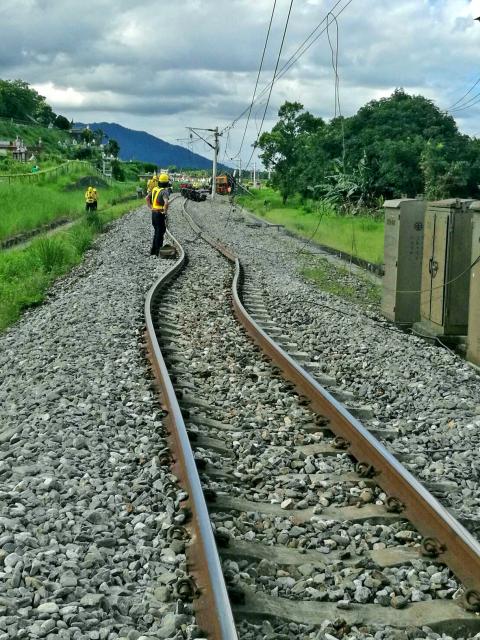Two passengers were injured when a Tzuchiang-class express train derailed in Hualien County yesterday afternoon, the Taiwan Railways Administration (TRA) said.
The derailment occurred at 2:49pm when the train, which had begun its trip at Kaohsiung’s Sinzuoying Station and was carrying 200 passengers, was on its way to Hualien, the TRA said.
The Nos. 7, 8 and 9 carriages derailed when the train was between Fuyuan (富源) and Guangfu (光復) stations, with the latter two carriages overturning on the side of the tracks.

Photo: CNA, provided by a member of the public
The No. 7 carriage was left severely tilted to one side.
Two female passengers sustained minor injuries and were taken to the Taipei Veterans’ General Hospital Fonglin Branch in Fonglien (鳳林).
The TRA said the derailment also damaged three transmission towers, 100m of power lines, 300 pre-stressed concrete sleepers and 300m of track.

Photo: Wang Chin-yih, Taipei Times
Full operations on the damaged section of track are due to resume by 12pm today.
The TRA said that the derailment had affected the schedules of 37 trains and an estimated total of 5,300 passengers.
Yesterday’s incident was the second derailment on the Hualien-Taitung line this month.
On June 4, high temperatures were suspected to have caused the tracks to deform, leading to a derailment of a northbound Chukuang-class train.
The temperature of the affected tracks was recorded at 63°C, higher than the 60?C the tracks are designed to withstand.
None of the 50 passengers on that train suffered major injuries, but the incident severely damaged 250m of train track.
Asked about the cause of yesterday’s derailment, the TRA said that the temperatures on the track were measured at 54?C, which did not exceed the temperature limit.
It said footage from surveillance cameras on the train did not indicate any unusual occurance and that an investigation would be conducted to determine the cause of the incident.
The deformation of the tracks could have been caused by derailment or by the train driver applying the emergency brakes, it said.
The design of the tracks could be flawed as well, the TRA added.

The Central Weather Administration (CWA) yesterday said it expected to issue a sea warning for Typhoon Fung-Wong tomorrow, which it said would possibly make landfall near central Taiwan. As of 2am yesterday, Fung-Wong was about 1,760km southeast of Oluanpi (鵝鑾鼻), Taiwan’s southernmost point, moving west-northwest at 26kph. It is forecast to reach Luzon in the northern Philippines by tomorrow, the CWA said. After entering the South China Sea, Typhoon Fung-Wong is likely to turn northward toward Taiwan, CWA forecaster Chang Chun-yao (張峻堯) said, adding that it would likely make landfall near central Taiwan. The CWA expects to issue a land

Taiwan’s exports soared to an all-time high of US$61.8 billion last month, surging 49.7 percent from a year earlier, as the global frenzy for artificial intelligence (AI) applications and new consumer electronics powered shipments of high-tech goods, the Ministry of Finance said yesterday. It was the first time exports had exceeded the US$60 billion mark, fueled by the global boom in AI development that has significantly boosted Taiwanese companies across the international supply chain, Department of Statistics Director-General Beatrice Tsai (蔡美娜) told a media briefing. “There is a consensus among major AI players that the upcycle is still in its early stage,”

The Central Weather Administration (CWA) yesterday said it is expected to issue a sea warning for Typhoon Fung-wong this afternoon and a land warning tomorrow. As of 1pm, the storm was about 1,070km southeast of Oluanpi (鵝鑾鼻), Taiwan’s southernmost point, and was moving west-northwest at 28 to 32kph, according to CWA data. The storm had a radius of 250km, with maximum sustained winds of 173kph and gusts reaching 209kph, the CWA added. The storm is forecast to pass near Luzon in the Philippines before entering the South China Sea and potentially turning northward toward Taiwan, the CWA said. CWA forecaster Chang Chun-yao (張峻堯) said

Japanese Prime Minister Sanae Takaichi yesterday said that China using armed force against Taiwan could constitute a "survival-threatening situation" for Japan, allowing the country to mobilize the Japanese armed forces under its security laws. Takaichi made the remarks during a parliamentary session while responding to a question about whether a "Taiwan contingency" involving a Chinese naval blockade would qualify as a "survival-threatening situation" for Japan, according to a report by Japan’s Asahi Shimbun. "If warships are used and other armed actions are involved, I believe this could constitute a survival-threatening situation," Takaichi was quoted as saying in the report. Under Japan’s security legislation,